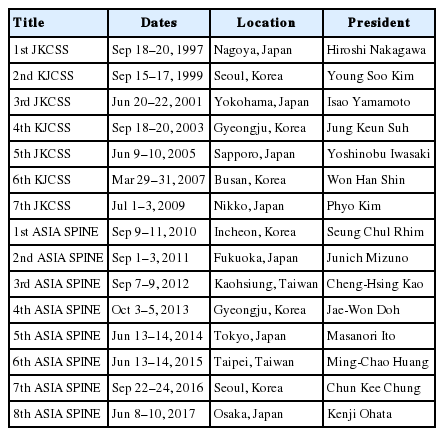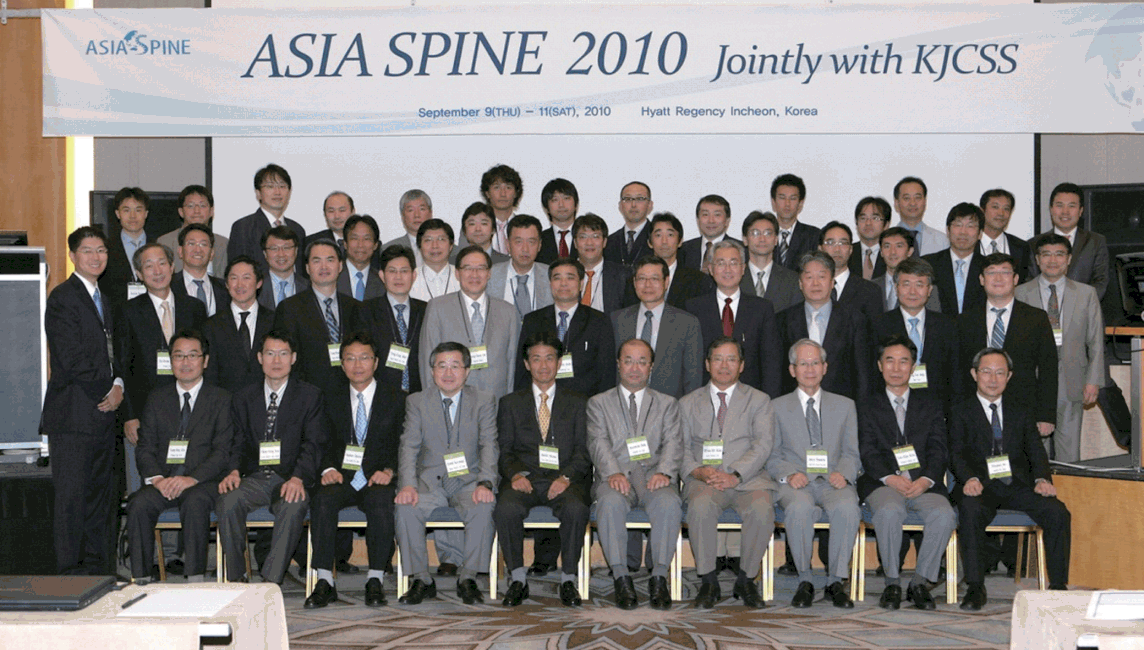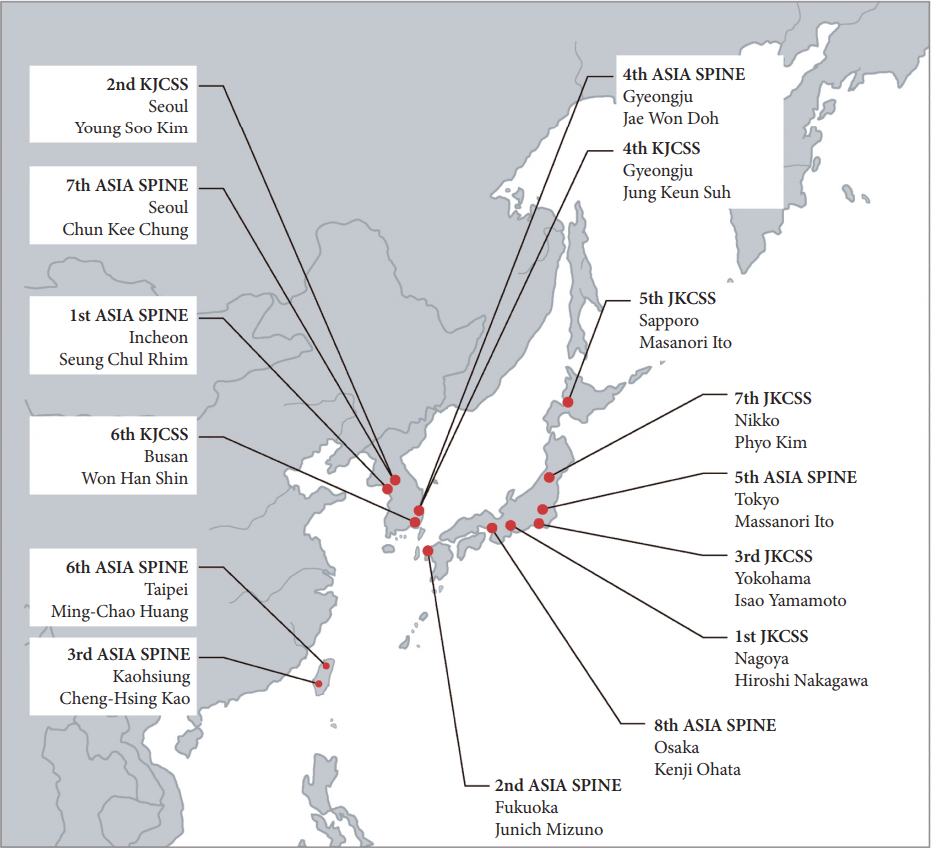ASIA SPINE: The Past, Present, and Future
Article information
Abstract
The sharing of international academic accomplishment and friendship is important; furthermore, to better understand and anticipate the future, we should look back and remember where we started. Regarding ASIA SPINE, the authors aimed to record how the pioneers of Asian spinal surgery started this spine meeting series more than 20 years ago and that later developed into the present state of the conference. The authors will also explore the possible future of this conference. In June 1996, when Professor Hiroshi Nakagawa organized the 11th Annual Meeting of the Japanese Society of Spinal Surgery, spinal neurosurgeons from Korea and Japan including Professor Young Soo Kim, Professor Jung Keun Suh, and Professor Nakagawa discussed the establishment of a multinational conference on spinal surgery via a partnership between the 2 countries. Finally, from September 18 to 20, 1997, the First Biennial Meeting of the Japan-Korea Conference on Spinal Surgery was held in Nagoya, Japan, with Professor Hiroshi Nakagawa as the first organizing President. From then, a biennial meeting was held every other year in Korea or Japan until 2009. In September 2010, the next generation of spinal neurosurgeons decided to organize the first meeting of ASIA SPINE in Incheon, Korea, in order to represent all Asian spine specialists. This meeting has been since held annually around the region including in Taiwan. Remembering the pioneers in the field of spinal surgery is invaluable and extremely important. The authors hope that interest in ASIA SPINE will further expand to other nations in Asia who have advanced philosophies and refined technologies. We wish ASIA SPINE continued success and the ability to promote prolonged international friendship among the Asian countries .
INTRODUCTION
Asia is the largest and most populous continent on Earth, existing mainly in the eastern and northern hemispheres [1]. Asia accounts for about 30% of the total area of the Earth, and its 4.5 billion people constitute roughly 60% of the world’s population. Asia is notable not only for its overall large size and population, but also its dense and large settlements and vast barely populated regions. The continent, which has long been home to the majority of human beings, was the site of many of the first civilizations [1].
ASIA SPINE was established, organized, and developed with the aim of creating the best spine-related society in Asia, much like Europe’s Eurospine and North America’s North American Spine Society (NASS) [2,3]. Initially, it was a friendship exchange between Japan and Korea in the form of a biennial meeting of the Japan-Korea Conference on Spinal Surgery (JKCSS). In later years, the region of participation was expanded to East Asia. The first ASIA SPINE Conference was held in Incheon, Korea, from September 9 to 11, 2010.
Sharing academic accomplishments internationally and establishing cross-border friendships is important. Regarding ASIA SPINE, the authors would like to discuss how the pioneers of Asian spinal surgery introduced the precursor to this spine meeting more than 20 years ago and later developed the present state of ASIA SPINE and discuss its possible role in the future. This manuscript describes the formation process of ASIA SPINE and discusses future development directions. The purpose of this paper was to understand the future of ASIA SPINE by looking back and remembering where it started.
BIRTH OF THE BIENNIAL KOREA-JAPAN CONFERENCE ON SPINAL SURGERY
An international spinal meeting was held in Cebu, Philippines, from January 27 to 28, 1996, and included several spinal surgeons from Korea and Japan (Fig. 1). When Professor Hiroshi Nakagawa (Aichi Medical University), Professor Junichi Mizuno (Aichi Medical University), and Professor Kazutoshi Hida (Hokkaido University College of Medicine) were looking for the fourth player for their tennis game as a social activity during the meeting, they found and invited Professor Jung Keun Suh (Korea University College of Medicine) [4]. Thus, the 4 of them became friends. It is for this reason that Professor Jung Keun Suh says tennis was a bridge-builder not only between Korean and Japanese spinal neurosurgeons, but also between Korean and Japanese spinal neurosurgical societies later on [4].
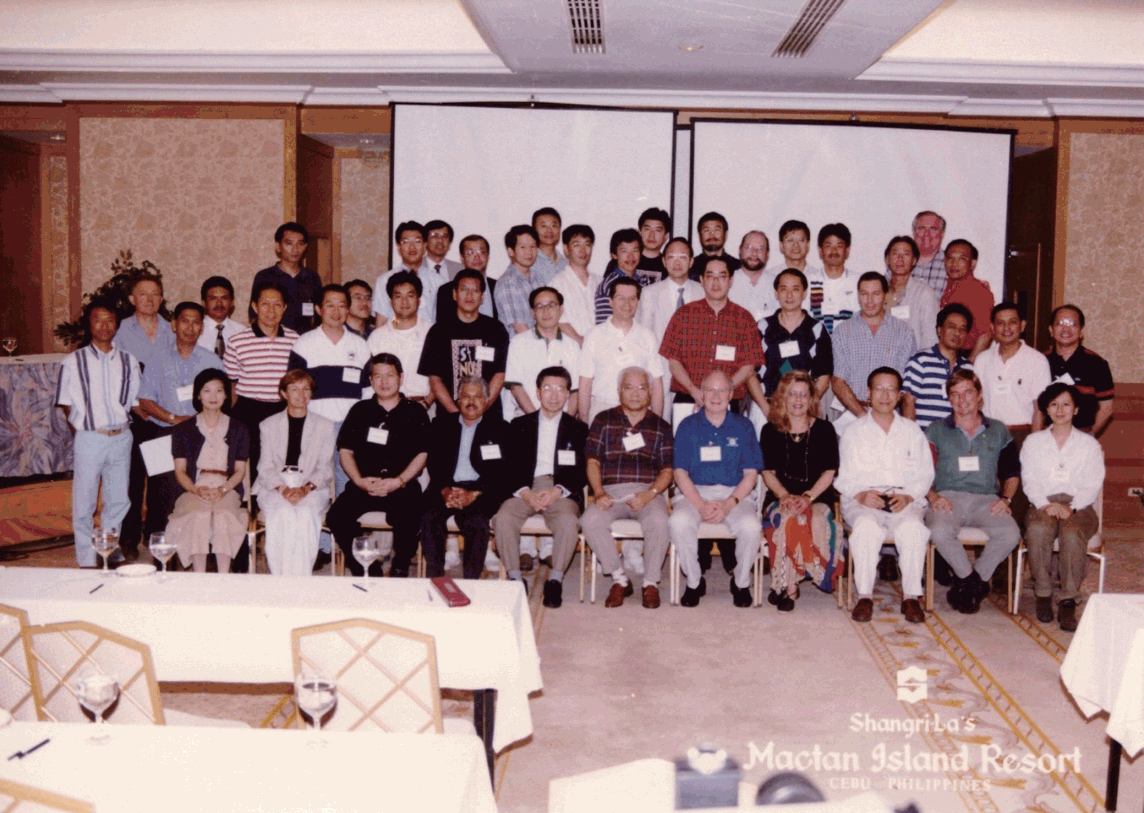
The International Spinal Meeting at Cebu, Philippines, from January 27 to 28, 1996. Dr. Nakagawa, Dr. Mizuno, and Dr. Hida from Japan and Dr. Kim and Dr. Suh from Korea first met at this meeting and exchanged their scientific ideas and opinions regarding spinal surgery.
Five months after the conference, Professor Hiroshi Nakagawa invited Professor Young Soo Kim (Yonsei University College of Medicine), Professor Sun Kil Choi (Hallym University College of Medicine), and Professor Jung Keun Suh to the 11th Annual Meeting of the Japanese Society of Spinal Surgery in Nagoya, Japan, which was held from June 6 to 7, 1996, and organized by Professor Nakagawa as the President. At this meeting, Professor Nakagawa, Professor Kim, Professor Choi, and Professor Suh discussed the establishment of a joint conference on spinal surgery between the 2 countries. Subsequently, from September 18 to 20, 1997, the First Biennial Meeting of the JKCSS was held in Nagoya, Japan, with Professor Nakagawa as the first organizing President. Under the 2 main topics of “spinal instrumentation” and “ossification of the posterior longitudinal ligament,” a total of 64 oral presentations and 35 poster presentations were included at the meeting, with 50 presentations originating from Japan and 49 from Korea [2,4].
Then, from September 15 to 17, 1999, the Second Biennial Meeting of Korea-Japan Conference on Spinal Surgery (KJCSS) was held in Seoul, Korea, with Professor Young Soo Kim as the organizing President. Beginning with these 2 initiating conferences, a total of 6 conferences were held alternatively between Korea and Japan. The meeting was called the KJCSS when it was held in Korea and the JKCSS when it was held in Japan. The details of the KJCSS and JKCSS meetings are summarized in Fig. 2 and Table 1. The last biennial JKCSS was hosted by Professor Phyo Kim of Dokkyo University and held in Nikko, Japan, from July 1 to 3, 2009.
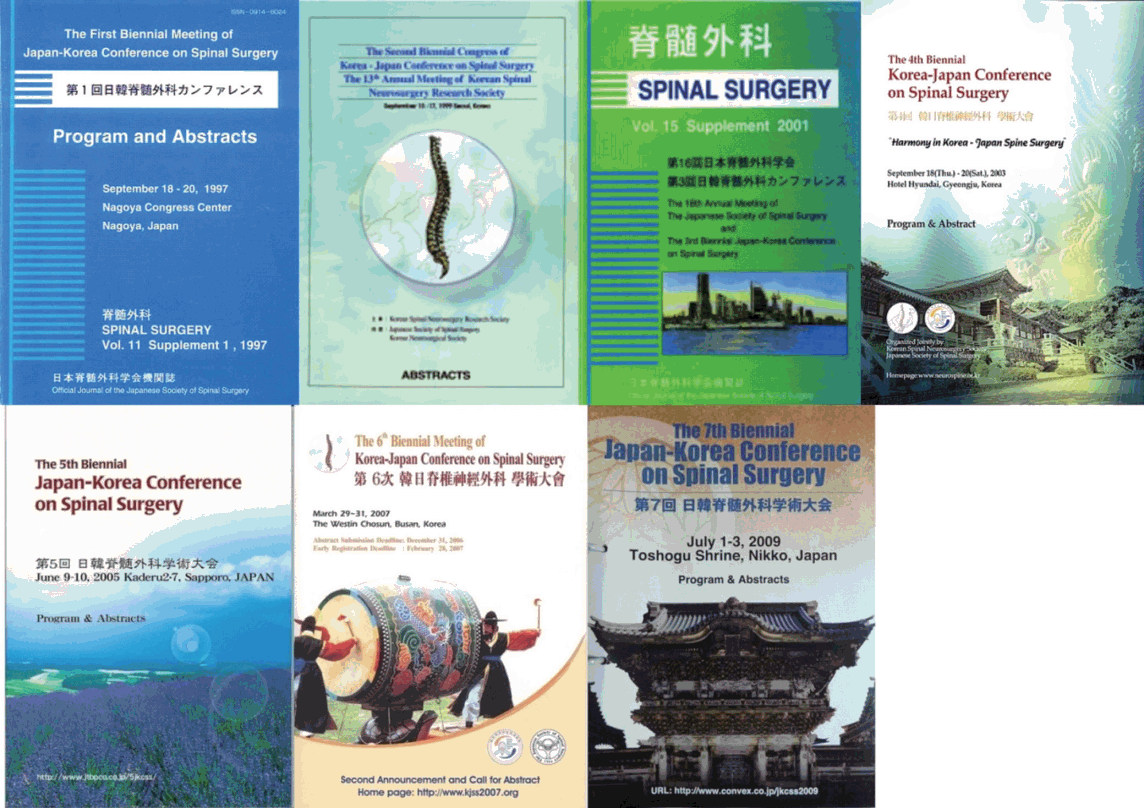
The cover pages of the program books of past Korea-Japan and Japan-Korea Conferences on Spinal Surgery.
BIRTH OF ASIA SPINE
In September 2010, the next-generation members of KJCSS decided to organize ASIA SPINE in order to represent spine surgeons from across the whole of Asia. They opted to hold conferences sequentially in Korea, Japan, and Taiwan, and opened the conference to participants from other Asian countries [3]. In order to take over the genealogy of KJCSS, the society was named as ASIA SPINE, and the scope of participation was extended to China, Taiwan, Australia, and other Asian countries. At that time, there were many innovative developments ongoing in the field of spine around the world. The earliest goal of ASIA SPINE was to promote academic exchanges, mutual understanding, and cooperation among Asian spinal surgeons.
The first ASIA SPINE conference was held in Incheon, Korea, from September 9 to 11, 2010, jointly with the 24th Annual Meeting of the Korean Spinal Neurosurgery Society [2,3,5]. At the first ASIA SPINE meeting, 280 participants from Korea, Japan, Taiwan, the United States, China, and Australia gathered to share their knowledge about spinal diseases and surgical treatment and to promote academic exchanges and mutual friendship through discussion (Fig. 3). Thereafter, a total of eight conferences were sequentially held in Korea, Japan, and Taiwan (Fig. 4).
During the seventh ASIA SPINE, which was held jointly with the 30th annual meeting of the Korean Spinal Neurosurgery Society in Seoul, Korea, September 22–24, 2016, honorary membership was awarded to Professor Hiroshi Nakagawa by the Korean Spinal Neurosurgery Society in recognition of his important role in the birth of KJCSS. With the main theme of “translation in spine care,” more than 600 participants from 18 countries (Korea, Japan, Taiwan, USA, China, India, Singapore, Mongolia, Nepal, Indonesia, Cambodia, Malaysia, and so on) attended the meeting, and a total of 180 presentations were made.
The most recent conference, the eighth ASIA SPINE meeting, was held jointly with the 32nd annual meeting of the Neurospinal Society of Japan (the former Japanese Society of Spinal Surgery) from June 8 to 10, 2017 in Osaka, Japan. The main subject of this joint meeting was “division and integration for the future.” More than 800 spine surgeons attended the meeting, from countries such as Japan, Korea, Taiwan, Nepal, Thailand, Saudi Arabia, Indonesia, and India, and more than 500 abstracts were presented at the meeting. During the eighth ASIA SPINE joint meeting with the Neurospinal Society of Japan, meritorious awards were presented to Professor Young Soo Kim and Professor Jung Keun Suh in recognition of their roles in the foundation of ASIA SPINE.
All of the former presidents of the KJCSS/JKCSS and ASIA SPINE conferences are presented in Fig. 5, and the details of the ASIA SPINE meetings are summarized in Table 1 and Fig. 6.
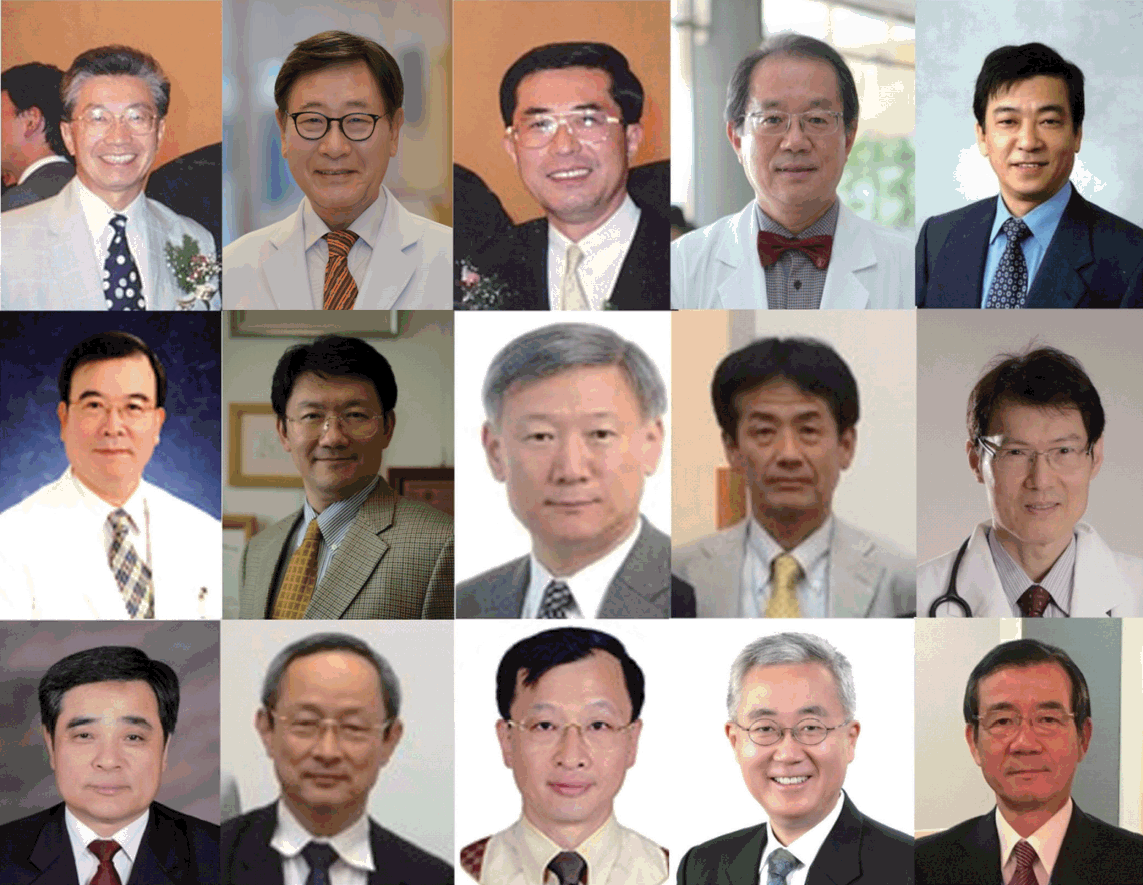
The former presidents of the Korea-Japan Conference on Spinal Surgery and ASIA SPINE. From the top left to the top right: Hiroshi Nakagawa, Young Soo Kim, Isao Yamamoto, Jung Keun Suh, Yoshinobu Iwasaki, Won Han Shin, Phyo Kim, Seung Chul Rhim, Junich Mizuno, Cheng-Hsing Kao, Jae-Won Doh, Masanori Ito, Ming-Chao Huang, Chun Kee Chung, and Kenji Ohata.
FUTURE PERSPECTIVES
Although the specialization of medical technology may lead to more advanced medical care, there will be always a risk of its uneven distribution. It will be meaningful for us to continue to discuss such important matters including cutting edge advancements of spine technology, recent procedures of spinal care, and challenging spine cases on an international level. Early on in Europe and North America, there were conferences for that purpose. Eurospine, the Spine Society of Europe, was founded on June 26, 1998, in Innsbruck, Austria. The aims of Eurospine are to stimulate the exchange of knowledge and ideas in the research, prevention, and treatment of spine diseases and related problems and to coordinate efforts undertaken in different European countries for further development in this field. The Eurospine annual meeting has grown exponentially, with last year’s meeting in Berlin, Germany, attracting more than 3,000 delegates and 159 exhibitors. The NASS was founded in 1985 with a goal of promoting evidence-based and ethical spine care. The NASS does this by enacting policies and actions aimed at promoting education, research, and advocacy in other health care fields related to the spine. NASS membership consists of roughly 8,000 health care professionals, including orthopedic surgeons, neurosurgeons, physiatrists, anesthesiologists, researchers, and other related practitioners. In the near future, ASIA SPINE will surely become an established organization equivalent to these societies. The authors hope that interest in ASIA SPINE will further expand to other nations in Asia with advanced philosophy and refined technology. We wish ASIA SPINE continued success and the ability to promote prolonged international friendship among the Asian countries.
During the ASIA SPINE meeting in 2017, the presidents of ASIA SPINE and spine societies in Japan, Taiwan, and Korea agreed to publish a journal representing the academic achievements of members of ASIA SPINE. Thus, the Korean Journal of Spine was renamed Neurospine, which is the official journal of ASIA SPINE, the Neurospinal Society of Japan, Taiwan Neurosurgical Spine Society, and the Korean Spinal Neurosurgery Society [6]. The main purpose of publishing this journal for ASIA SPINE is to develop a higher level of academic and medical knowledge in spine and spinal cord issue diagnosis and treatment to help the people of Asian countries and other countries around the world. Using Neurospine, we believe that spinal neurosurgeons in Asian countries and other parts of the world will be able to share experiences and scientific achievements through a thorough peer review process and subsequent article publishing.
CONCLUSION
The biennial KJCSS was founded by pioneers in 1996. ASIA SPINE was founded in succession to the biennial KJCSS in 2010. It is expected that ASIA SPINE will become a dignified society that will encompass all of the spine specialists in Asia in the near future.
Notes
The authors have nothing to disclose.
Acknowledgements
The authors would like to thank Kenji Ohata and Toshihiro Takami at Osaka City University in Japan for comments on this manuscript.

